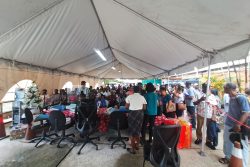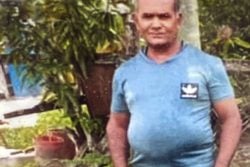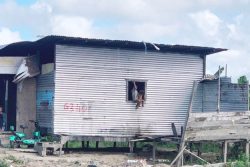The maternal grandparents of murdered 16-year-old Neesa Gopaul are dissatisfied with the outcome of the recently concluded trial that found their daughter guilty of the killing, saying the police did a poor investigation and the judge and jury gave credence to questionable evidence.
Stressing that no concrete evidence was led to find their daughter Bibi Sharima-Gopaul guilty, the elderly Mohammed Kayum and his wife Abida also insisted that the sentence handed down by Justice Navindra Singh to Sharima-Gopaul was too harsh and opined that it was fuelled by selective media coverage and a desire to satisfy the public.
“Justice nah deh in this country. If yah poor yah doom,” Kayum told Stabroek News during a recent interview at the couple’s West Bank Demerara home, where he and his wife said they have endured years of frustration and hurt as the case made its way through the court system.

Sharima-Gopaul and her former lover Jarvis Small were convicted of the 2010 murder of the teen two weeks ago. Sharima-Gopaul, the teen’s mother, was sentenced to 106 years in prison and Small to 96 years after a 12-member jury returned a guilty verdict at the conclusion of their almost month-long trial at the High Court.
The prosecution said they murdered the girl between September 24 and October 2, 2010 and stuffed her body into a suitcase. The suitcase was then thrown into the creek at Emerald Tower Resort, where it was anchored with dumbbells.
The lawyers for both accused have indicated that they will be appealing the conviction.
Even though there appeared to be considerable public satisfaction with the outcome of the case, some of the evidence presented by police witnesses highlighted deficiencies in crime scene analysis and the investigative capacity of the force.

Police admitted during the trial that they charged Sharima-Gopaul and Small without any evidence against them and they could not provide a reasonable excuse for why they did not recover crucial evidence—the dumbbells that were used to anchor the suitcase with body and which witnesses said belonged to Small—until several days after the discovery of Gopaul’s body.
The police’s evidence provided no proof that investigators did all they could to tie together all the circumstantial evidence in their possession.
Some observers, both in the Guyana Police Force and in the legal fraternity, say that based on the evidence led, the sentencing of the two accused might not have been fair. They say too that police investigators and the hierarchy of the police force ought to see the trial as a learning experience and come up with ways to ensure that all crimes, whether high profile or not, are investigated thoroughly to the extent that a solid case is presented to the court.
‘They ain’t do the right thing’
Sharima-Gopaul’s parents, however, believe that the deck was always stacked against their daughter.
The couple, now raising Sharima-Gopaul’s surviving daughter, said the evidence was not properly analysed. Abida, who maintains that there was no reason why her daughter would have killed her own child, further insisted that both the judge and the jury erred in their decision. “They ain’t do the right thing that they supposed to do. They sink she more than how they sink he,” the emotional woman lamented, while noting that her daughter has been given a “death sentence” since she can’t possibly live for the next 106 years. She has been visiting her in prison every three months since her incarceration and she says it is always a sad experience that is filled with tears.
Kayum, meanwhile, expressed displeasure at this newspaper’s coverage of the trial, saying that critical parts of his testimony were excluded from reports. He said everything he had to say was very important because it showed that his daughter and granddaughter were being drugged and constantly abused by Small. He added that this newspaper also failed to publish part of his testimony where he said Small had kicked down a door.
“What the media supposed to write in the court dem nah write nothing. Only what they feel to write…At least me ain’t no schala but meh got lil undastanding,” he said
“For five long years, the media carry sheer nonsense,” the man added, while charging that it was the “incomplete and negative coverage” which propelled his daughter’s conviction.
He expressed disappointment that the judge, while giving direction to the jury, did not mention the abuse that was meted out to Sharima-Gopaul and Neesa. “I only waste time,” he said, referring to his testimony. “I was ah rubbastamp… wha meh granddauta tell me is wha meh talk,” he further insisted
The couple said too that the evidence led by convict Simone De Nobrega about Sharima-Gopaul poisoning her own husband was untrue. They said the man had done numerous blood tests prior to his death and they did not reveal any poisoning. He died from kidney failure and diabetes-related complications, they maintained.
De Nobrega, who turned up to testify and was afterward taken into custody to serve a five-year sentence handed down when she absconded during her own trial, claimed she was a former cellmate of Sharima-Gopaul and that the woman had confided in her.
Kayum questioned why the media would print the testimony of a convict. “That had to be one mad mudda to tell her anything,” the man said. “In this whole world, none mudda ain’t gon kill dey chile,” he added.
According to Kayum, he is still amazed that the judge and jury could believe De Nobrega, but not him. He called the woman a liar and added that her testimony at the trial was set in motion since the matter was in the lower court.
Not properly investigated
Sharima-Gopaul’s parents also told Stabroek News that they were not satisfied with the way the police investigated the case as leads given to them were ignored. “We are not satisfied of nothing, not the police, the judge or nobody,” Kayum said.
Kayum contended that had the police investigated properly, they would have realised that they had no evidence to bring a charge against Sharima-Gopaul. The man complained bitterly about a police investigator who allegedly turned a blind eye to reports that Gopaul had been drugged and raped.
Meanwhile, a security source knowledgeable about the investigation told this newspaper he was not pleased with it. His biggest concern was that the investigators might have left the scene too quickly. “What is the rush? The person is already dead, so what is the big rush?” he questioned.
The source said that there was no coordination between investigators and crime scene ranks and this poses a big problem as the two groups need to work together. This collaboration should include visiting the scene together to ensure that proper processing takes place. He said based on his information, the two groups visited the scene separately.
According to the source, it also appeared as if too many persons were involved in the investigation. In future, he said, the police need to explore the establishment of a group of experienced investigators and crime scene experts to whom reference can be made in cases such as the Gopaul murder.
According to the source, supervision and case management were huge
problems when it came to criminal investigation. “A lot more could have been done to bring the case together,” the source said, before calling on the police to properly review the case to see if the investigation was properly conducted.
Crime Chief Leslie James recently said that the force continuously addresses the issue of crime scene investigation.
Asked by Stabroek News if at the end of a high-profile trial police would review the police evidence given in a bid to highlight strength and weaknesses, James responded, “We always endeavor to review our investigative skills. I should say that at the moment we are looking at a programme referred to as the strategic management programme. It commenced in 2014 and goes up to 2017 and training is part of that programme. So, we are continuously training our ranks.”
Asked if there were any concerns with the police evidence given during the Gopaul trial, he said, “We continuously examine our posture whenever it comes to us that our ranks may not have been totally professional. I am not saying that this was situation in this case but if that comes to our attention we do deal with them.”
Observers say the police’s evidence during the trial had huge gaps and even up to the end of the trial there was no holistic account of how the teen met her death.
Under cross-examination during the trial, Superintendent of Police Hugh Jessemy agreed with suggestions made by the defence that when the duo was charged the police had no evidence against them. Jessemy also agreed that when he joined the investigation on October 6, 2010, he did not enquire from other investigators, what evidence they had—if at all they had any evidence—linking Small to the crime. He admitted too that up to the point when the accused were arraigned on October 8, 2010, the police had no evidence against them.
The lead crime scene expert, while on the stand, was confronted with oversights in the processing of the area where the girl’s body was found.
Police Corporal Floyd Hosannah could not recall many aspects of his investigation and tried to explain inconsistencies in his testimony. When asked by defence attorney Glenn Hanoman if he had completed his processing of the crime scene on the day the body was discovered, Hosannah said “to an extent.”
Hanoman then asked the witness whether, in those circumstances, he had gone back to the scene to ensure that the processing was complete. He, however, said no, triggering sighs of disbelief by some in the courtroom.
The senior crime scene expert, who was anxious to provide an explanation for not returning to the scene, said that while he did not return, he had told his superior that he wanted to go back. He later agreed with Hanoman’s suggestion that had he gone back to the scene, there might have been additional evidence that could either point to or away from the accused. The senior rank acknowledged that he did not attempt to speak to the occupants of a building at the entrance of the resort. His excuse was that that area was not a part of the crime scene.
Hosannah admitted that he had wanted to see what the rope, which kept the suitcase anchored in the water, had been tied to and that it occurred to him that it may be something of evidential value but he offered an explanation for not persisting.
According to him, since he had attempted to pull the rope and failed to bring the anchor to the surface, he did not think it wise to have another rank try. He also offered the darkening skies as another reason for not persisting.
He said that yellow crime scene tape was later placed around the area but no one remained at the scene throughout the night.
The rank said too that no attempts were made to lift fingerprints off the dumbbells, which were later retrieved, because they were in water.
Civilian witness Nazar Mohamed Okeelan later testified that the dumbbells were those that he had sold to Small. There was also testimony that a piece of rope, which was found to be attached to the dumbbells, had been seen at Sharima-Gopaul’s home. However police admitted that nothing was done to verify this information.





